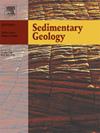The Balanoglossites ichnofabrics in the aftermath of the Permian-Triassic mass extinction
IF 2.9
2区 地球科学
Q1 GEOLOGY
引用次数: 0
Abstract
Trace fossils are widely distributed in pre-extinction Permian successions, and are also relatively common in the Lower Triassic strata. They have been used for evaluating the recovery process of marine infaunal ecosystem following the Permian-Triassic (P-Tr) mass extinction. However, one complicated ichnogenus Balanoglossites has not been clearly recognized and described in the Early Triassic previously, and its importance in revealing biotic recovery in the aftermath of the P-Tr mass extinction has not been evaluated. Here we documented Balanoglossites ichnofabrics from the Lower Triassic Yongningzhen Formation of the Yongningzhen section from Guizhou Province, South China. Balanoglossites is characterized by three-dimensional complex burrow system with Y-shaped and J-shaped galleries and multiple openings, and the herein described form is assigned to B. triadicus. Microstructures of Balanoglossites under SEM and EDS revealed oxidized pyrite framboids occurred merely near the burrow wall, which may be related to activities of the trace maker and symbiotic microorganism such as sulphate-reducing bacteria. Raman spectrum mapping showed that organic matter was enriched along the burrow boundaries of Balanoglossites, but was lacking in the burrow fill. This pattern may result from the impregnation of the burrow walls with organic mucus and bioirrigation by the trace maker. Polychaetes are considered as the most possible trace makers of Balanoglossites, and they were opportunistic pioneers that proliferated in the Early Triassic. The low ichnodiversity of Balanoglossites-bearing strata contrasts with coeval ichnoassemblages, which probably results from intense bioturbation by deeper-tier burrows that prevents the preservation of surficial to shallow-tier trace fossils. Although Balanoglossites is a complex burrow, its occurrence in the Early Triassic is not an indicator of the full recovery of infaunal ecosystem.
二叠纪-三叠纪大灭绝后的Balanoglossites
微量化石在灭绝前二叠纪地层中分布广泛,在下三叠统地层中也较为常见。它们被用来评价二叠纪-三叠纪大灭绝后海洋动物生态系统的恢复过程。然而,在早三叠世,Balanoglossites这一复杂的鱼属尚未被明确认识和描述,其在揭示P-Tr大灭绝后生物恢复中的重要性尚未得到评价。本文记录了贵州永宁镇剖面下三叠统永宁镇组balanoglosites的技术结构。Balanoglossites的特征是三维复杂的洞穴系统,具有y形和j形的通道和多个开口,本文所描述的形式被分配给B. triadicus。对balanoglosites的SEM和EDS显微结构分析表明,氧化黄铁矿仅出现在洞壁附近,这可能与微量制造物和硫酸盐还原菌等共生微生物的活性有关。拉曼光谱图显示,Balanoglossites沿洞界富集有机质,而在洞充填体中缺乏有机质。这种模式可能是由于有机黏液浸渍了穴道壁和痕迹制造者的生物灌溉造成的。多毛类被认为是最有可能留下balanoglosites痕迹的物种,它们是在早三叠纪大量繁殖的机会主义先驱。含balanoglosites地层的低生物多样性与同期的生物组合形成鲜明对比,这可能是由于深层洞穴的强烈生物扰动,阻止了浅层痕迹化石的保存。虽然Balanoglossites是一个复杂的洞穴,但它在早三叠世的出现并不能说明水生生态系统的完全恢复。
本文章由计算机程序翻译,如有差异,请以英文原文为准。
求助全文
约1分钟内获得全文
求助全文
来源期刊

Sedimentary Geology
地学-地质学
CiteScore
5.10
自引率
7.10%
发文量
133
审稿时长
32 days
期刊介绍:
Sedimentary Geology is a journal that rapidly publishes high quality, original research and review papers that cover all aspects of sediments and sedimentary rocks at all spatial and temporal scales. Submitted papers must make a significant contribution to the field of study and must place the research in a broad context, so that it is of interest to the diverse, international readership of the journal. Papers that are largely descriptive in nature, of limited scope or local geographical significance, or based on limited data will not be considered for publication.
 求助内容:
求助内容: 应助结果提醒方式:
应助结果提醒方式:


